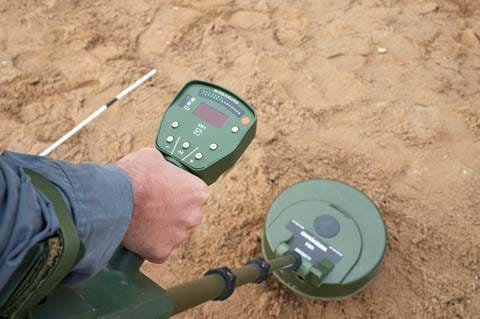VR1 Wirehound for IED and Mine Clearance Operations
An Artios Global Case Study

Artios, a well-known British company, delivers counter explosive ordnance training and capacity development projects to governments, international institutions, NGOs and commercial companies in some of the world’s most challenging areas. Recently Artios have been working with the HALO Trust and the UN Mine Action Service to build capacity in Afghanistan, including in the use of specialist detection procedures.
To find out more on how Artios Global has been increasing and improving EOD capability around the world, we caught up with Director, Mike Kennedy.

"The majority of a searcher/deminers time is spent on time consuming excavation and/or confirmation procedures. As the primary sensor used in detectors in Mine Action is metal this means that searcher/deminers spend a large percentage of their time investigating benign signals.
This is known and understood by most organisations; however it is still often difficult to justify the additional cost to donors / contracting authorities for detectors incorporating additional sensors."
In 1944, Sappers in the British Army were pictured on their hands and knees clearing mines from Normandy beaches. In these treacherous times, soldiers would scan and clear areas of Explosive Remnants of War (ERW) with the use of basic metal detectors. Despite the advancement of the technology used for metal detection, it is still difficult to provide reliable and accurate detection in Mine Action and Counter-IED operations.
As threats evolved, Ground Penetrating Radar was developed and combined with handheld metal detectors by manufacturers such as Chelton and Vallon. Compared with metal detection alone, a dual sensor is capable of detecting objects with metal and metal-free components and at greater depths.
"We have been developing capacity to survey and clearance abandoned IEDs in Afghanistan since 2018, when we started providing assistance to The HALO Trust. In 2020, we then partnered with HALO to deliver a project on behalf of UNMAS to build this capacity in national NGOs, who account for approximately 50% of the country’s capacity to survey and clear explosive ordnance.
This project produced a number of qualified instructors, in areas including search, disposal and operational management. We have now extended this project in 2021/2022 to provide mentoring for these instructors.
The main challenges have been stability and political. During our first project we were able to deploy a sizeable team of international staff into Afghanistan. This time around our international staff are working remotely and will be providing training virtually and through the use of literature we have created.
Already we have influenced the UN’s decision to incorporate Vallon VR1 detectors with Chelton’s GPR sensors by successfully communicating the productivity benefits compared to other handheld detectors."
Abandoned Improvised Explosive Devices pose some of the biggest threats following the recent conflicts in Afghanistan and Iraq With low production costs and readily available components, IEDs will likely remain a weapon of choice for adversaries in many years to come. As well as the obvious danger to life, ERW also deny access to food, water and other basic needs for the local population.



"Low clutter rates from the VR1 means a deminer/searcher spends far less time on excavations. This means per deminer you get a much higher productivity rate.
The VR1 is much easier to provide initial staff training on and maintain user competency compared to other detectors. There is also less of a requirement for users to interpret signals meaning that in Mine Action, quality management checks and inspections are easier to implement on both processes and the output (cleared land)."
The VR1 Wirehound is known more commonly as ‘The Cable Detector’. Using Chelton’s GPR sensor incorporated into Vallon’s detector, the VR1 has been specifically developed to find explosive devices and their components - most notably trigger wires and cables typically used in the construction of IEDs.
...using Ground Penetrating Radar to support counter-IED and mine clearance operations. Trusted by The US Marine Corps, The British Army and The HALO Trust, our dual-detection technologies save both lives and time in the fight to remove explosive remnants of war across the world.
Your quote basket is currently empty
 Please select the type of quote you require for this product:
Please select the type of quote you require for this product: